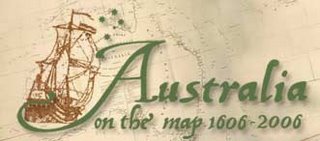Australia's 400th anniversary of European contact

"Australia on the Map: 1606-2006 (AOTM) is dedicated to encouraging the people of Australia plan events for 2006 to commemorate the 400th anniversary of the first europeon contacts with our continent. Our focus is particularly on the many Mariners who (whether by accident or design) charted our coasts – and put 'Australia on the Map', thereby making it known to the world ...
"Before any Australian history was written down the Original Australians lived here for more than 40.000 years. They may be the oldest continuous population in the world. Many hunted and gathered for their livelihood, some lived in semi-permanent villages. They arrived here from the North, group after group and occupied the continent ... Every Australian should know the name of Willem Janszoon and his ship the Duyfken, the first recorded ship and crew to chart an Australian coast as well as the first to meet with Aboriginal people ..."
AOTM
OK, gang, let's try a nice thought experiment
When Dutchman Willem Janszoon landed here in 1606 it was centuries after large merchant fleets of 25-ton ships from what is now called Indonesia had regularly been coming from the north to what is now called Australia -- as far as to Melbourne, at the far south of the continent -- for trade in trepang, a marine animal considered a delicacy by the Chinese. This trade with the Aborigines of Australia might have been going on since the 12th Century in the days of Richard the Lionheart and Saladin, as I discuss in the article Robin Hood and his merry Sea Cucumbers.

The distances the Makassans sailed were vast (see map above: from Makassa to Melbourne is as good as Makassa to Africa). What if a Makassan ship traded with the Court of Kublai Khan (1215–1294)? What if an Australian Aboriginal sailor was on board? Why not? After years of trade between the two peoples, they surely picked up some of each other's languages. A strong native Australian might have been considered a good person to employ -- or enslave -- for ship duties.
What if a Chinese ship then took him to the North Sea via Africa? As we know from China's Kangnido Map (pictured below; it has provenance going back to 1330), Chinese sailors knew the whole coast of Africa, Europe and the Mediterranean, and even the name of Germany, which they transliterated as 'Alumangia' for the Latin word for Germany, Alemania.

What if my hypothetical Indigenous Australian seaman found his way to Germany, spent some time in a hotel enjoying draft Heinecken and frauleins, got to London, thence aboard a Crusader ship (maybe he was present at a battle at Jerusalem), thence another trading vessel, made it to South-east Asia, got another job on a Makassan prow, and ended up dying back home in the south of Australia with his lederhosen pockets stuffed with coins and trinkets from Germany, Norway, Greece, Malta, Libya, England, Jerusalem, Egypt, Iraq, Eastern Africa and Khan's China?
If his grave were found today in Melbourne, would Australia and the world revise its fantasy that "Nothing ever happened in Australia for 40,000 or 60,000 years, then Britain's Captain James Cook discovered it in 1770"?
Another point to note: 10th-Century Viking treasures (such as the Cuerdale Hoard) have been found in England that contained silver from as far afield as Afghanistan and Russia. Our 13th Century Aboriginal adventurer might have Afghan and Rusky coins in his pocket as well. Wouldn't Australia's Prime Monster John Howard be annoyed that some 'Abo' had done all that 700 years ago??!!
Tagged: australia, indigenous, aboriginal, maritime, history, china, australian+history, alternative+history







0 Comments:
Post a Comment
<< Home